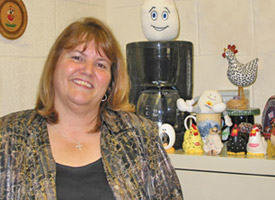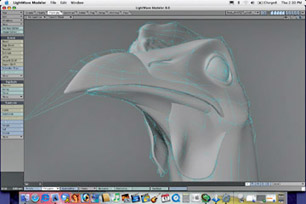Native Texan Patricia Curtis Leading Poultry Peak

Patricia Curtis
Patricia Curtis, director of the Auburn University Poultry Products Safety and Quality (PPSQ) Peaks of Excellence program, has been anticipating the poultry science department's upcoming move to the a new building later this year
The increased amount of laboratory space, the occasions for collaborative research among poultry science and food science faculty and the expanded research on food processing will all mean opportunities for greater recognition. That will suit Curtis just fine.
In the two and a half years that Curtis has been at the helm, the PPSQ has increased the visibility of and regard for CoAg's poultry science department. One of the greatest kudos to date came in November 2003 when Meat & Poultry, the business journal of the North American meat and poultry industry, ranked the department fourth in the nation for its programs specializing in poultry processing.
"Even before the Peaks program began, this department had strong industry support. It had the strongest industry support of any department that I'd ever been in before. The Peaks program has been like the icing on the cake," states Curtis.
A native Texan, Curtis is not satisfied with the status quo; to her, bigger has always been better.
Curtis grew up in Mesquite, Texas, a suburb of Dallas, where her parents owned a florist business. After receiving a B.S. degree in home economics education in 1979 from Texas Women's University and M.S. (1982) and Ph.D. (1985) degrees in food science and technology from Texas A&M University, Curtis began working at the University of Wisconsin–River Falls, just across the border from St. Paul, Minn. There she taught 12 different courses in an academic year, was adviser for a students' organization and worked part-time with faculty development.
In 1991, Curtis took a job at North Carolina State University as Extension specialist for poultry processing. About that time the U.S Food and Drug Administration launched HACCP–Hazard Analysis Critical Control Point, a systematic approach to food production as a means of assuring food safety–and Curtis once again took on a big job.
"HACCP rules are subject to each poultry inspector's interpretation, so the people who run the poultry plants are always trying to figure out how to meet those rules," she says. "My job was to find the research data and provide it to industry to show the inspectors the science behind what they [the industry] were trying to accomplish."
Thus, Curtis was propelled into the food law area–an area she continues to work in today. What began as the development of a single online course in food law has grown into a desire to form a consortium of universities that would offer a "cafeteria" of online poultry science courses.
Curtis' bigger-is-better approach is also illustrated by her growing interest in developing components to improve online courses. One of the problems associated with distance education in scientific subjects is laboratory experience. Working with other poultry science faculty and several information technology staff at Auburn, Curtis has received a USDA higher education challenge grant to create a "virtual chicken."
"We want to use a variety of technologies to create a three-dimensional replica of a chicken, so that online users will be able to view different parts of the chicken from all angles. We're starting with the female reproductive tract to show how an egg is formed, and eventually we'll have the whole chicken," says Curtis.

The Virtual Chicken may soon be part of AU's online poultry science courses.
The Virtual Chicken will be adaptable for use by different audiences by changing the terminology used in the audio component. Different terminologies will be available in the audio components listened to by extension agents, undergraduate students and graduate students. The Virtual Chicken will also be used for online continuing education for high school teachers. Curtis is already partnering with the University of Georgia to develop teaching activities to accompany the Virtual Chicken.
In the late 1990s, while at N.C. State, Curtis met Don Conner, head of the poultry science department at Auburn, when they collaborated on an egg production research project. Curtis had a patent for cryogenic cooling, a system that cools eggs using carbon dioxide gas as they are readied to be packaged for market. Cryogenic cooling reduces the time for cooling eggs from days to minutes and produces a safer, higher-quality egg.
The U.S. Poultry and Egg Association had asked Curtis to continue her research on the cryogenic cooling of eggs, and Conner had a student who needed a research project. The only catch was that the research team had to run the egg processing facility, which was rented for the project.So Curtis hired eight undergraduate students from N.C. State and, along with Conner's graduate student, ran the egg processing facility.
"I have a new appreciation for the people who grade eggs in egg processing plants," comments Curtis. "On an egg grading machine, rows of eggs move across a light, and the person grading eggs is supposed to pull out all the eggs that have cracks. The eggs are moving at a rate of 360 cases per hour, and one case has 30 dozen in it. That's three dozen eggs a second that you are supposed to look at!"
During this collaboration, Conner told Curtis about the then-newly hatched PPSQ Peaks program. Curtis was intrigued by the opportunity that the program presented: promoting the production of wholesome, high-quality poultry products in a globally competitive manner. This was a challenge of the magnitude that Curtis could appreciate. In 2002, Curtis became director of the PPSQ Peaks program.
While Curtis is thrilled about moving into the new CoAg poultry science building, she believes that the poultry science department now needs a modern, state-of-the art farm.
